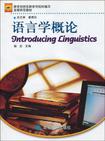语言学概论
出版时间:2002-12 出版社:高等教育 作者:杨忠主编 页数:165
Tag标签:无
前言
《语言学概论》是为英语教师进修和英语专业学生编写的教材,旨在帮助读者掌握现代语言学的基本概念、基本理论、基本方法,引发对语言本质、语言学习过程和语言教学原理的思考。 21世纪,世界经济一体化的趋势必然带来国际交流与合作的新局面。英语作为国际交流的通用语言越来越受到社会各界的重视。大规模、高效率的英语教学是以高水平、专业化的英语教师培养、培训为基础的。听、说、读、写、译技能是从事英语教学必须具备的,但不是英语教师职业化培训的全部。外语教学是由政府决策、专家策划、教师操作、社会评价构成的系统工程。教师直接面临的问题是怎么教。然而,教无定法,教师需要根据教育目标、教学对象、教学内容、教学设备等诸多因素创造性地设计课程步骤。教师不仅要考虑怎么教,还必须考虑为什么教,教什么。语言教师应该知道语言是什么,语言是由什么构成的,是如何发挥作用的,是如何习得的。语言学研究成果对语言教师颇有启发。外语教学法是语言理论与教学实践结合的产物。有语言理论知识外语教师才能深入理解教学大纲和课程标准,才能驾驭教材,才能创造性地组织课堂教学,提高教学效果。 语言学的研究领域广泛,派别林立,术语繁多,合理地取舍是编好语言学概论的基础。本书以介绍现代英语语言学的基本理论、方法和前沿问题、最新成果为主要目的,全书由三部分构成。第一部分(第一章)概述语言的本质、功能、分类、起源和语言学的对象、性质、分支。第二部分(第二~七章)介绍语言的分相研究,即语音学、音位学、形态学、句法学、语义学、语用学。第三部分(第八~十章)介绍语言的交叉学科研究,即社会语言学、第二语言习得、语言学与外语教学。为了便于读者消化理解语言理论,掌握语言分析的基本方法,每章后附辅导题和研究课题。书后附辅导题参考题解和英汉术语表。
内容概要
权威性:本套教材系教育部师范司组编的英语专业规划教材。编者与审者均为国内知名专家、教授及多年从事师范英语教学的优秀教师。针对性:本套教材汲取了国内外最新外语教学研究成果,理论与实践并重,针对教师实际需要精心编写。实用性:本套教材在选材与练习设计上以培养学习者综合语言应用能力为宗旨,注重提高其业务能力。
书籍目录
CHAPTER I Language and Linguistics: an Overview1.1 What is language? 1.2 Features of human language 1.3 Functions of language 1.4 Types of language 1.4.1 Natural languages and artificial languages1.4.2 Genetic classification of languages1.4.3 The typological classification of languages1.5 The myth of language: language origin 1.6 Linguistics: the scientific study of language 1.6.1 Linguistics as a science1.6.2 Branches of linguistics1.6.3 Features of modern linguisticsTUTORIAL ACTIVITIES / QUESTIONS MINI-PROJECTS CHAPTER 2 Phonetics: the Study of Speech Sounds2.1 The study of speech sounds 2.2 The sound-producing mechanism 2.3 Phonetic transcription of speech sounds 2.3.1 Unit of representation2.3.2 Phonetic features and natural casses2.4 Description of English consonants2.5 Description of English vowels2.6 phonetic features and natural classesTUTORIAL ACTIVITIES/QUESTIONSMINI-PROJECTSCHAPTER 3 Phonology: the Study of Sound Systems and Patterns3.1 The study of sound systems and patterns3.2 Phonemes and allophones3.3 Discovering phonemes3.3.1 Contrastive distribution3.3.2 Complementary distribution3.3.3 Free variation3.3.4 The discovery procedure3.4 Distinctive features and non-distinctive features3.5 Phonological rules3.6 Syllable structure3.7 Sequence of phonemes3.8 Features above segments3.8.1 Stress3.8.2 Intonation3.8.3 Tone3.8.4 The functioning of stress and intonation in EnglishTUTORIAL ACTIVITIES/QUESTIONSMINI-PROJECTSCHAPTER 4 Morphology: the Study of Word Structure4.1 Words and word structure4.2 Morpheme: the minimal meaningful unit of language4.3 Classification of morphemes 4.3.1 Free and bound morphemes4.3.2 Inflectional and derivational morphemes4.4 Formation of English words4.4.1 Derivation4.4.2 Compounding4.4.3 Other types of English word formationTUTORIAL ACTIVITIES/QUESTIONS MINI-PROJECTS 44CHAPTER 5 Syntax: the Analysis of Sentence Structure5.1 Grammaticality ……CHAPTER 6 Semantics:the Analysis of MeaningCHAPTER 7 Pragmatics:the Analysis of Meaning in ContextCHAPTER 8 Language in Social ContextsCHAPTER 9 Second Language AcquisitionCHAPTER 10 Linguistics and Foreign Language TeachingAppendix 1 Families/Groups of LanguagesAppendix 2 The Indo-Europena Language FamilyBibligraphy Suggested Solutions to Tutrial QuestionsAn English-Chinese Glossary
章节摘录
but Nim and other chimpanzees in similar experiments showed almost notendency toward such creativity (Fromkin and Rodrnan, 1998). Facts like these seem to suggestthat creativity is a feature that distinguishes human language from communication systems ofother creatures. (ii) Duality Language contains two subsystems, one of sounds and the other of meanings. If you aregiven the four English speech sounds [p] [1] [i] [d] and asked to combine them into sequencesthat sound like English words, you will find [plid] [pild] are permissible, while *[pdli] *[dpli]*[lipd] *[idlp], etc. are not. The permissible sequences sound like English words, and yetthey are not, because they do not stand for anything. On the other hand, meanings are conveyedby certain speech sounds or sequences of speech sounds. In English, [DEAD BODY OF APERSON] is expressed by the word corpse. In this case, we say the concept or the meaning islexicalized. In English there is no word to stand for the concept [DEAD PLANT]. Whencertain speech sounds correspond to a certain meaning, a unit of language arises. The samesounds can be recombined to mean something else. In some cases, the same sequence ofsounds can mean different things (such as homophones, and polysemes). This sh ws thatmeanings and sounds make up two subsystems of language. No systems of animalcommunication possess this feature. The barks of a dog are not analyzable. Animalcommunication systems cannot be cut into segments and then be reorganized into meaningfulsequences. In other words, human languages are discrete while animal communication systemsare non-discrete. (iii) Arbitrariness The relationship between speech sounds and the meanings they represent in the languagesof the world is, for the most part, an arbitrary one. The Swiss linguist de Saussure regarded thelinguistic sign as composed of signifier (sound image) and signified (referent). In his view,there is no inherent relation between the two. A building we live in with our family is calledhouse in English, maison in French, dom in Russian, casa in Spanish. If the relationshipbetween speech sounds and meanings were motivated (i.e., not arbitrary), the words in theselanguages that stand for the same thing would sound the same or similar, then people wouldnot need to learn foreign languages. Admittedly, there are a few words in most languages that are onomatopoetic——words ofwhich the sounds supposedly imitate the sounds of nature. This seems to contradict arbitrariness.Nevertheless, when these words of different languages are compared, it is found that they stillsound different.
图书封面
图书标签Tags
无
评论、评分、阅读与下载
用户评论 (总计0条)
相关图书
- 英语初级口语
- 中学英语辅助系列
- 阅读(高一)(朗文中学英语辅助系列)
- 便捷英语语法
- 英语初级口语
- 特效视窗--Visual Basic 开发高级界面实例 (平装)
- (2005最新版)十年考研英语真题全析全解(1995-2004年)(配磁带)
- 清华幼儿英语2a教师用书
- 清华幼儿英语2b教师用书
- 洋话连篇3:情景喜剧说美语(17VCD+书)
- CNN英语视听总第6期
- 我为英语狂•VCD+CD CNN英语视听魔戒3:王者归来(2碟附书) (平装)
- 数字电路设计与Verilog HDL
- 2004高考重点线英语听力(磁带)
- 互联网开放贸易协议
- 商贸英语应用文大全
- 美国校园英语
- 大学英语实用语法教程
- 构建虚拟专用网
- 英语口译教程
- UNIX系统管理技术
- 数据网络设计
- 英语口译教程
- 秘书宝典
- 网络协议
